Bustin' Out! Asexual Goddess Births
Starting in the Epic period of Hinduism (400 B.C.E. - 400 C.E.), the Hindu gods and goddesses began to appear in epics, like the Mahabharata and Ramayana, where they accrued mythic stories, characteristics and origins.1 Hindus still read these myths today, in addition to the many other stories that were recorded during the Classic (400- 600 C.E.) and Medieval (600- 1800 C.E.) periods, and continue to appear today, in this modern period.2
Are the Hindu myths meant to be models for human life? Do they reflect Indian morals and values? Or are the gods and goddesses "living" in a separate sphere, with different rules and constraints? One could argue both sides, especially if you are willing to look at the Hindu myths as allegories that are meant to teach lessons about love, power and death. But the myths that describe the births of the primary goddesses in the Hindu pantheon differ greatly from the accepted human mode of procreation. None of the great goddesses are born through the union of a wedded male and female (lingam and yoni), or even an unwedded couple! Instead, they emerge, fully grown, from the body of a god or goddess, from the combined energies of a group of gods, or from some aspect of nature.
BORN of a GOD
Sarasvati Goddess of Speech, Learning and Culture
The female half of god --
One myth says that Sarasvati was born of the god Brahma who "desiring to create the world, goes into meditation, whereupon his body divides in two, half male and half female. Enraptured by his female half, who is Sarasvati, Brahma desires her, mates with her, and creates the demigod, Manu, who subsequently creates the world." Another stories claims that Sarasvati came from the god Krishna, who also "divides himself into male and female, purusha and prakriti , spirit and matter. . . his female half takes on five forms or five shaktis, dynamic powers, one of which is Sarasvati."3 |
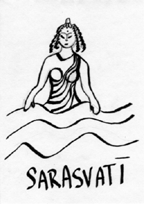 |
Devi Mother Earth
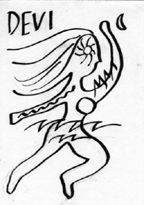 |
The energy of god, or the substance of the universe?
The creation myth in the Brahmanas proposes that the world was born when the god Prajapati, "undertook great austerities and subsequently released his immense stored up energy."4
But more often, Devi is seen as being the ultimate being, from whom all of creation and the great gods spring. The Devi-bhagavata-purana says that Devi is "the life force in all beings, the ruler of all beings" (1.5.51-54) and the creator and commander of Brahma, Vishnu and Shiva (3.5.4).5 The world is all part of her body; "the oceans as her bowels, the mountains as her bones, the rivers as her veins, . . . the trees as her body hair. . . the sun and moon are her eyes, and the nether worlds are said to be her hips, legs and feet (7.33.21-41)."6 |
BORN of NATURE
Sita The Wife of Rama, the model Hindu wife and devotee
Born from the dust --
Sita also has a supernatural birth. Her father, King Janaka, was plowing fields and from them, she emerged. She was born from the fertility of the earth, but her mortal father was the catalyst.17 |
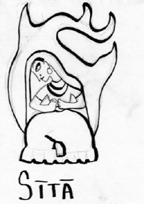 |
Sri-Lakshmi Goddess of Auspiciousness, wealth and luck
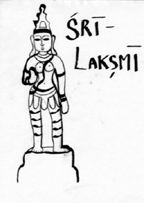 |
| The Essence of the Churning of the Ocean --
In the most common myth of Lakshmi's birth, Lord Vishnu churns the ocean to obtain a nectar of immortality, and Lakshmi comes forth. She is beautiful and wondrous and becomes the consort of Vishnu.8 |
In some myths Sarasvati comes from tongues or speech. Her origin can be the tip of Krishna's tongue, Vishnu's tongue, or perhaps she was formed in Brahma's mouth when he spoke his first words.9
The River Ganga (Ganges) is also considered a goddess. The sacred river exists in the heavens, and flows down to earth from a hole in the sky above the Himalayan Mountains.
ONE from MANY
DurgaThe Great Warrior Goddess/Devi
"Let our powers combine!"
The great warrior goddess, Durga, came into existence when "the gods assembled and . . . emitted their fiery energies. This great mass of light and strength congealed into the body of a beautiful woman, whose splendor spread through the universe. The parts of her body were formed by the male gods. Her face was formed form Shiva, her hair from Yama, her arms from Vishnu, and so on." 10 |
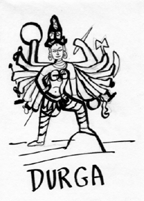 |
DURGA'S "CHILDREN"
Kali Ma Goddess of Death and Fury
 |
Fury from the forehead!
According to the Devi-hahatmya, once when Durga was engaged in battle with two demons, she became so angry that her skin turned black and Kali sprang from her forehead. "She is black, wears a garland of human heads and a tiger skin, and wields a skull-topped staff. She is gaunt, with sunken eyes, gaping mouth and lolling tongue. She roars loudly and leaps into the battle, where she tears demons apart with her hands and crushes them in her jaws."11 |
The MatrkasThe Seven Mothers
From the gods, or the Goddess?
There are a couple different myths about the origins of the Matrkas. One of the most popular medieval accounts is found in the Devi-mahtmya. In this tale, Durga is engaged in a battle with demons, when "the male gods, who are watching from the sidelines, create shaktis, female counterparts of themselves, to help Devi on the battlefield. Seven such shaktis are created, and in appearance they closely resemble the male gods from whom they are said to arise; Brahmani, created from the god Brahma, holds a rosary and water pot; Mahesvari, created from Shiva, is seated on a bull, holds a trident, wears serpent bracelets, and is adorned with the crescent moon; Kaumari, created from Karttikeya, rides a peacock and holds a spear; Vaishnavi, created from Vishnu, has the form of a boar; Narasimhi, created from the man-lion avatara of Vishnu, has the form of a woman-lion and throws the stars into disarray with the shaking of her lion's mane; and Aindri, created from the god Indra, holds a thunderbolt and is seatedon an elephant (8.11-20). Charging into the fray, this group of shaktis, collectively called the Matrkas (8.38, 44, 49, 62), tears into the deamon army and begins to slaughter them."12

The Matrkas are not viewed as consorts of the gods they are associated with, but as female aspects of the gods. It is also understood that the Matrkas are actually parts of Durga/Devi. Just as the gods had combined their powers to create Durga, so can their "contributions" separate into "helper" goddesses for the Great Goddess. One mythic account claims that the Matrkas came directly out of Devi's body, and are just named for the male deities.13
So do the Matrkas come from the gods or from Durga? Perhaps it does not matter, because Durga is the DEVI, the Great Goddess, and all the gods and the matter in the universe comes from her. In this light, the Matrkas complete a beautiful circle the goddess: Devi created all the gods, who in turn created Durga, and whether the Matrkas came from either Durga or the gods, they are still manifestations of the Great Goddess, Devi.
PARVATI and Her OVERLAPS
OR
DURGA -- Mothers and Daughters
Durga is often identified with the goddess Parvati; they are both considered the consort of Shiva and the Skanda-purana says that Durga is actually a form of Parvati.14 This arragnement gets even more complicated when you bring Kali into the picture. Kali often manifests herself in Parvati's rage, and is considered part of Parvati, as well as of Durga. Kali stands on top of a prone Shiva in many Hindu paintings, and although she is considered a "single" goddess, she is often associated with Shiva. Can Kali, Parvati and Durga all be consorts of Shiva, and also manifestations of each other? The answer is "yes," if you believe all the goddesses are ONE.
ParvatiGoddess of Domestication and the Household
Mortal Birth, Divine Offspring --
Parvati's birth was necessary so that Shiva could have offspring. A son of Shiva was the only hope for defeating an evil demon who was threatening the world.
Parvati was born human and became the wife of Shiva by performing great auterities. When she and Shiva were united thier lovemaking was so intense that the gods were afraid and interuppted them. Shiva's
seamen fell to earth and landed in the Ganga, and Kattikeya emerged (who later defeated the aforementioned demon). Parvati desired her own child, so she created Ganesha from the dirt and sweat of her own body.15 Siva got jealous and decapitated the boy, but when Parvati got mad and demanded that his head be put back, Shiva gave him the head of an elephant. Portraits of the "Royal Family" often leave out Kittikeya, but include Ganesha, who is one of the few gods who is portrayed both as a child and later as a fully grown god. |
 |
Durga's Four Children: Karttikeya, Ganesha, Sarasvati, and Lakshmi15
During the Durga-puja, an important Hindu festival for Durga, the goddess is often portrayed with her "four children," Karttikeya, Ganesha, Sarasvati, Lakshmi.16 This festival bega as an agricultural festival, and later became associated with military sucess. Why are these specific gods and goddesses considered her children?
Karttikey and Ganesha are the children of Parvati, with whom Durga is often identified. That connection is clear. Sarasvati was born when the great god Brahma (or Vishnu) divided himself into two: male and female, purusha and prakriti , spirit and matter. If Sarasvati represents the dynamic prakriti and matter of a great god, and in turn, of the universe, then of course, she comes from Devi and is part of her. The inclusion of Lakshmi is perhaps due to the fact that she came from the Ocean, "the bowels" of Devi. It also aludes to Lakshmi's association with agriculture, and the earth.17All four of these gods and goddesses were brought into the universe by ONE god or goddess. By making them children of Durga, they recieve a second parent -- DEVI, the MOTHER of US ALL.
PROCREATION IN THE COSMOS vs. ON EARTH
Are the Hindu myths meant to be models for human life?
Do they reflect Indian morals and values?
Or are the gods and goddesses "living" in a separate sphere, with different rules and constraints?
David Kinsley says in Hinduism: A Cultural Perspective the women's "role in society is to seve, give birth to, and nourish males."18 In Hindu culture, childbirth is acceptable only within matrimony. Hindu women aim to bear sons for their husband, so that his lineage will continue.
In the cosmos, the gods and goddesses are imortal, thus reducing the need to pass on their lineage. Marriage is also much more loosely defined in the Hindu pantheon; many gods have multiple consorts.19 The role of the goddesses is serve the world, and be served, praised and petitioned to by humans. Some goddesses are associated with a god whom they serve, e.g. Sita and Lakshmi, but others are independant, e.g. Kali and Durga. Moreover, in the cosmos, being "married" to a god does not imply childrearing. Sita and Lakshmi are childless, yet are widely praised by Hindus. And Durga and Parvati's unusual meathods of reproduction are certainly not meant to be models for human procreation.
Therefore, I conclude that the goddesses are not meant to be models for mortal women, in terms of childbearing.
The Goddesses are the DIVINE MOTHERS of US ALL.
All ART by A. Bowie Snodgrass, December 1998.
1. David R. Kinsley, Hinduism: A Cultural Perspective (Englewood Cliffs NJ, 1993), p15-16.
2. Kinsley, Hinduism, p 18.
3. David R. Kinsley,Hindu Goddesses (Berkeley, 1986), p 57-58.
4. Kinsley, Goddesses, p178.
5. Kinsley, Goddesses, p133.
6. Kinsley, Goddesses, p 179.
7. Kinsley, Goddesses, p 68.
8. Kinsley, Goddesses, p27.
9. Kinsley, Goddesses, p 58.
10. Kinsley, Goddesses, p96-97.
11. Kinsley, Goddesses, p118.
12. Kinsley, Goddesses, p 156.
13. Kinsley, Goddesses, p 158.
14. Kinsley, Goddesses, p. 95-96.
14. Kinsley, Goddesses, p. 44.
16. Kinsley, Goddesses, p 95.
17. Kinsley, Goddesses, p 33.
18. Kinsley, Hinduism, p 135.
19. Lakshmi and Sarasvati are both associated with Vishnu; Parvati, Devi and Kali are all associated with Shiva;
Please direct questions and comments to absnodgrass@vassar.edu.






